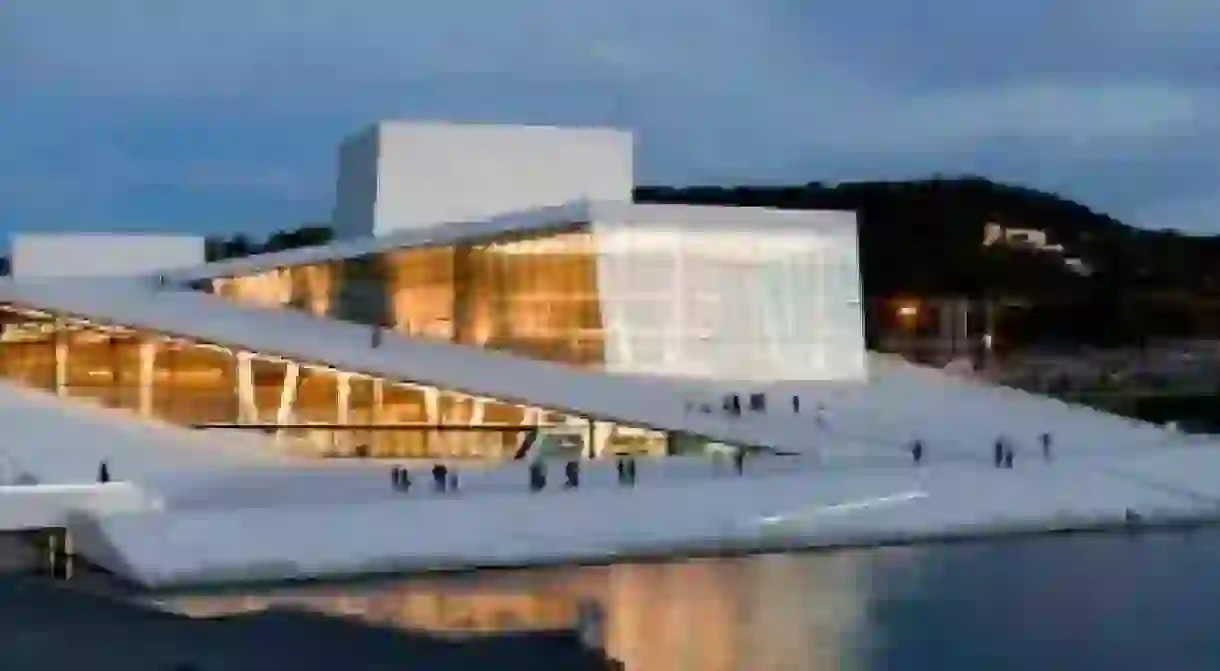The Top 10 Things To Do And See In Bjørvika, Oslo

With the redevelopment of the Oslo bay area, Bjørvika has become a revitalized part of Oslo where design and architecture have been allowed to flourish. The opera building has become a natural focal point in the area with the debated Barcode buildings looming in the background. With new portions of the seaside promenade, trendy restaurants and city beaches opening up every year, this part of Oslo is one to watch in the years to come.
The Norwegian National Opera and Ballet
Opera House

A spectacular display of contemporary Nordic design, created by renowned Norwegian architects, Snøhetta, is the Norwegian National Opera and Ballet. A striking giant in white marble, the building itself is worth a visit, but also for the view of the fjord from the rooftop, the two high-end restaurants, the sleek interiors of oak and the world class performances. Take a walk down to the water and enjoy this iconic Oslo building, as it rises from the fjord like a glacier.
Oslo Waterfront Promenade
As a part of the urban renewal project, Fjord City, Oslo’s waterfront is seeing a lot of new developments and exciting additions. One of these features is an extensive promenade stretching all the way from the very east, through the city center and Bjørvika, and through to Frognerkilen in the west. With new areas opening up every year, the idea is a continuous walkway along the entire bay-area. With mmw architects at the head of design and spectacular views of Oslo and the innermost areas of the fjord, a walk along the promenade is bound to be a unique experience.

The Medieval Park
Church, Park, Ruins
Middelalderparken, or ‘the medieval park’, is a park situated a short walk away from Bjørvika. Technically a part of Oslo’s Old Town, the park contains ruins of the St. Clement’s Church and a medieval royal estate, as well as a constructed shoreline made to appear as the shoreline in Oslo did in the middle ages. Take a walk in the park, and experience this curious juxtaposition of the medieval ruins and the contemporary Barcode Project in the background. © Anne-Sophie/Flickr
Sørenga City Beach
Opened in June 2015, Sørenga City Beach is the newest addition to an ever expanding and revitalized shoreline in the Bjørvika bay area. Out on the tip of Sørenga lies the new city beach. It’s so popular that people are often seen queuing to find a spot in the summer. In a country with thousands of miles of available shoreline and beaches, this is a truly remarkable phenomenon. With a spectacular view of the fjord, this sandy beach offers a serene pit-stop in the middle of the high-rise jungle. Sørenga | © Rennings/Flickr
The Barcode
One of the most visible, and disputed, additions to the Fjord City is the Barcode Project, a redevelopment of the former dock area with several new high-rise buildings created by different architects. Housing banks, offices, apartments and restaurants, these buildings are worth a look if only for the striking figures they create on the Oslo skyline. Barcode forms the backdrop to the Opera and is yet another spectacular example of contemporary, Scandinavian designs in Oslo. Oslo Skyline | © Tore Bustad/Flickr
The Norwegian Museum of Contemporary Art
Art Gallery, Museum, Building

A short walk away from the Bjørvika shoreline lies the Norwegian Museum of Contemporary Art, displaying permanent and revolving exhibitions of art from ca. 1945 until today. With more than 5,000 works from Norwegian and international artists, the museum covers a broad register and exhibits works in many different mediums, including paintings, sculptures, film, and photography. Spanning two floors, this section of the National Museum is an exciting arena for contemporary artworks with guided tours and free entry on Sundays.
The House of Film
Filmens Hus, the ‘house of film’, is a building housing several different organizations working on film. Perhaps most notably the Norwegian Film Institute. While it’s primarily a place of business, there are also several areas and activities open to the public. Among those, there is Cinemateket where classic and contemporary film is screened, discussed and debated, and talks and workshops are held. The building is also home to the Norwegian film archives, a small film museum documenting Norwegian film history, as well as a newly opened café with a simple menu. Cinemateket | © Truus, Bob & Jan too!/Flickr
Norwegian Armed Forces Museum
Museum

If you move from Bjørvika’s bay area and in the direction of Akershus Fortress, you will encounter the Norwegian Armed Forces Museum, where Norwegian military history is documented and displayed. The museum recounts military efforts from the very first defenses in the Viking ages, until a lively occupation during the Second World War, and modern-day international war efforts. Through unique objects and artifacts, a long military tradition is displayed in what is one of the world’s most peaceful nations.
Kunsthall Oslo
Kunsthall Oslo is an independent exhibition space for contemporary art located in Bjørvika. As a non-profit establishment, Kunsthall displays international art, and emphasizes on ‘new commissions and a parallel commitment to exploring the social and historical.’ Increasingly popular among the public, Oslo Kunsthall aims to promote contemporary culture in Oslo and is definitely worth a visit if this is within your field or interest, or if you are simply curious. © thefuturistics/Flickr
Oslo Ladegård
Villa
Oslo Ladegård is a baroque stately home from the early 1700s situated in Oslo’s Old Town. Placed in a charming little park, the classic Scandinavian wooden villa, like Frogner Manor in the Frogner Park, displays beautiful interiors and authentic décor from the 18th and 19th century and also has a basement dating as far back as 1200. Oslo Ladegård is also home to a small café, with a large outdoor seating area, that serves what allegedly is the very best Italian pizza in all of Oslo. Oslo Ladegård | © ausfi/FlickrBy Linn Vardheim













